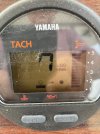- Joined
- May 15, 2021
- Messages
- 174
- Reaction score
- 31
- Points
- 28
- Age
- 64
- Location
- Burlington Vermont
- Model
- Gulfstream
Last week had the starboard alarm go off related to low oil in the reserve. Poured a gallon of yamalube in the reservoir and alarms went off and displayed ok on the gauge. Today went out fishing and six miles into trip gauge went from full to half to alarm in short period. Bad news was backup gallon was in my car. Shutdown the engine and nursed home with second engine with full oil reservoir.
Boat new to me three weeks ago. Where do I start looking? Engines not smoking so not burning excess oil. Nothing in Bilge. Never notice anything around external to engine displaying leak. Heading back out to boat tomorrow as raining this morning until tomorrow. Bugs me as engines had full maintenance performed in NY before bringing home to VT.
Any and all help is greatly appreciated. May pull boat tomorrow as want to replace the trim tabs as well.
Boat new to me three weeks ago. Where do I start looking? Engines not smoking so not burning excess oil. Nothing in Bilge. Never notice anything around external to engine displaying leak. Heading back out to boat tomorrow as raining this morning until tomorrow. Bugs me as engines had full maintenance performed in NY before bringing home to VT.
Any and all help is greatly appreciated. May pull boat tomorrow as want to replace the trim tabs as well.



